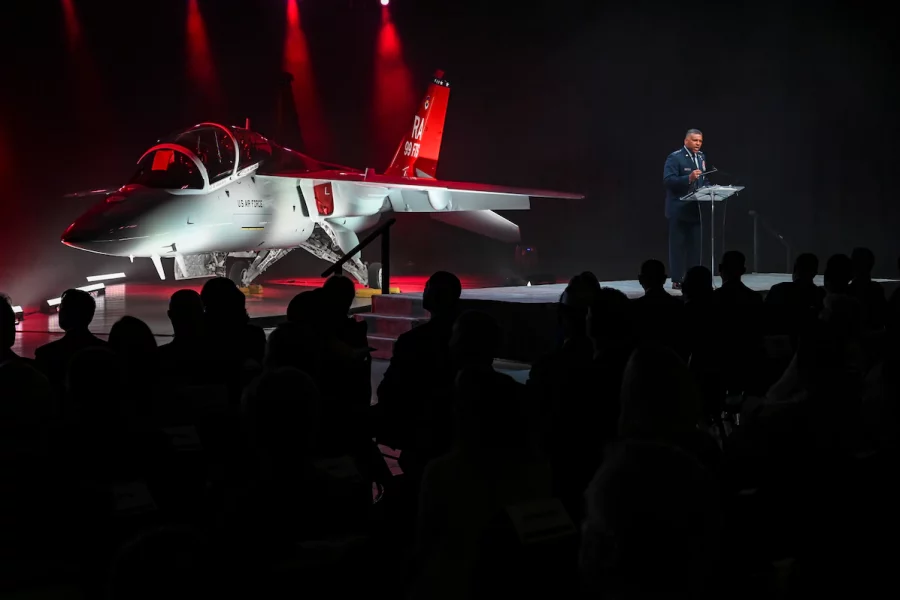Boeing unveiled the first T-7A Red Hawk advanced trainer for the Air Force at its St. Louis, Mo., facilities April 28, revealing a jet bearing the tail flash of the 99th Flying Training Squadron at Joint Base San Antonio-Randolph, Texas, which will be the first unit to operate the new airplane. The first T-7A squadron is to be operational in 2024.
The “Red Hawk” name, its red tail, and the 99th all pay recognition to the Tuskegee Airmen of World War II, some of whom were on hand for the ceremony. The canopy rail of the rollout jet was painted with the names of Red Tails commander, the late Brig. Gen. Charles McGee, and Lt. Col. George Hardy, who attended the event. Boeing showed videos honoring the Tuskegee Airmen and linking the jet to their legacy.

The T-7A has “already … revolutionized” how aircraft are designed and built, Boeing bombers and fighters vice president Steve Parker said, noting its digital design and the fact that the T-7 went from drawing board to first flight in 36 months. It “won’t be the last” new airplane designed this way, he said.
“It is history in the making,” Parker added, noting that the T-7 is the first new jet-powered trainer the Air Force has bought in more than 60 years.
Lt. Gen. Marshall B. “Brad” Webb, head of Air Education and Training Command, said AETC is in the process of “re-envisioning” how pilot training is done, and it is doing it “with the T-7 in mind.” The jet will take on the “fighter fundamentals” syllabus, along with much of the fighter and bomber training normally done on front-line equipment, thus freeing more front-line aircraft for battle and saving some of the cost of operating those more-expensive aircraft.
Webb called the T-7 “the relief pitcher” for the T-38, now in service more than 60 years. “We need the T-7,” he said. “We will have it for decades.”
Micael Johansen, president and CEO of Saab, Boeing’s T-7 partner which builds the center and aft fuselage, said the first aircraft shipsets from St. Louis and Sweden came together “in a precision join … in 30 minutes,” in a further testament to the soundness of the aircraft’s digital engineering. Saab is building new facilities in West Lafayette, Ind., to build T-7 components. The T-7 is the anchor for the company’s expansion into the U.S. market.
Lt. Gen. Richard M. Clark, superintendent of the Air Force Academy, said the T-7 is “the right tool” to put in the hands of USAF student pilots and called it a “game-changer” that will re-write pilot training.
Lt. Gen. Duke Z. Richardson, USAF’s top uniformed acquisition official and nominee for promotion to four stars and command of Air Force Materiel Command, also attended, although he did not make remarks. Chief of Staff Gen. Charles Q. Brown Jr. could not attend but was represented by his parents, Mr. and Mrs. Charles Brown. Former and current program managers and acquisition officials who worked on the T-7 also attended.
The rollout came a day after Boeing revealed that it lost $367 million on the T-7A in the first quarter of 2022. Company president and CEO David L. Calhoun said the company bet big on fixed-price development contracts such as the T-7; and that he will think twice about doing so in the future. But he said the aircraft will be in service “for decades” and will be built in large numbers, and should eventually be profitable for Boeing. The jet also represents new work at St. Louis as programs such as Boeing’s F/A-18 wind down there.
